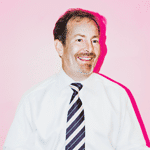
Photo: Samantha Simmons
An article you recently shared: “Ditching CPS for the Suburbs,” Chicago Reader, September 24, 2013.
The perfect city would have: Robust intercity, regional, and local mass transit connecting dense urban cores and “necklaces” of green space.
One technology on the horizon that can change the world: Large-scale interstate DC power transmission.
The next big idea will come from: Battery research, both grid-scale storage and portable storage.
Building you would save if the world was going to end: The Pantheon.
A century from now humanity will: Have curtailed global warming.
Harshest criticism you’ve ever received: Ralph Lerner, a visiting juror to University of Miami in my fourth year of a five-year program. I made a comparison of my project to another well-known building, and he ripped me a new one. Comparisons to famous buildings are unnecessary. I never made that mistake again.
Greatest professional pet peeve: The “starchitect” phenomenon, attributing buildings to individuals rather than teams.
Global topic that needs more attention: Carbon emissions. Yes, even more attention.
How to make the environment a non-partisan issue: Enhance incentives to innovation so that more clean-energy businesses will succeed in an unsubsidized market.
Most compelling argument for environmental stewardship: Survival.
Your personal definition of sustainability: Investing human capital, natural capital, and monetary capital wisely.
What you’d tell the green movement if it was your child: The upcoming adolescent years are going to be the toughest.
Saddest cutting-room floor casualty: New nuclear power generation.
Current project you’re most excited about: The Intrinsic School, an adaptive reuse of a 100-year-old lumberyard for a grades 7–12 charter school seeking to leverage blended learning.
Most impactful experience in nature: Fort Jefferson, Dry Tortugas. After the seaplanes and hovercraft leave the island around 4 p.m., it becomes a tranquil embrace of architecture and nature. I slept on the beach and kayaked around the island.
Your field’s biggest hurdle to improving its practices: Ignorance—right-brain and left-brain divide.
How you would explain “green” to a kindergartner: Living in cooperation instead of competition.
News source you hope will never die: CSPAN. Unfiltered.
The thought or idea that centers you: In the probabilistic haze, we remain in control of one thing: how many times we choose to step up to the plate.
Larry Kearns is a principal at Wheeler Kearns Architects in Chicago and served as the guest editor of gb&d‘s Mar/Apr 2014 issue. For more of Larry’s contributions to the magazine, click here.

